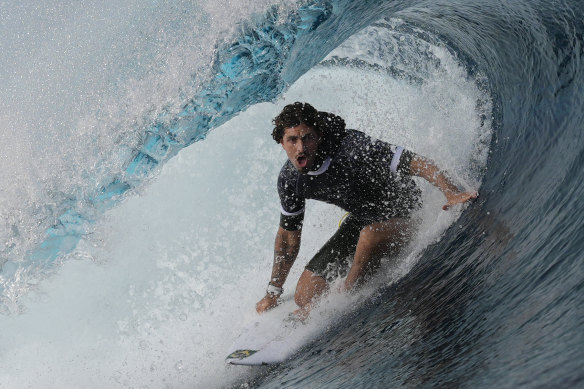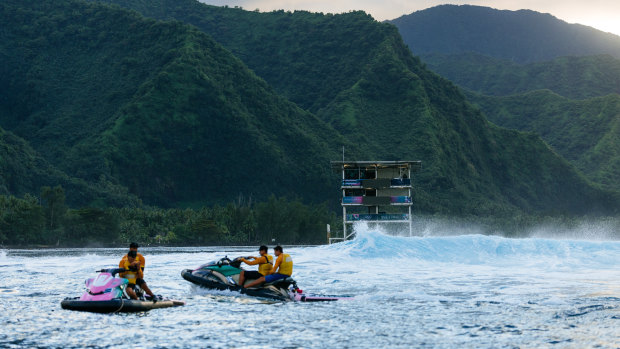Barrels and bikinis: Why surf holidays aren’t just for surfers
By Lee Tulloch
All eyes in our house have been on the Olympic surfing championships at Teahupo’o in Tahiti.
I don’t surf. In fact, I’m afraid of waves since being dumped as a kid in the roiling waters of Gippsland. But my husband, who grew up on Melbourne’s Mornington Peninsula, has been surfing from a young age and still makes his own boards.

Joao Chianca, of Brazil, in the barrel at Teahupo’o, Tahiti, on a training day ahead the 2024 Summer Olympics surfing.Credit: AP
Whether there’s good, uncrowded surf in a destination often colours our choice of holiday. Sri Lanka is ideal. The Yin Yang break in the Maldives, if you’re staying in the Laamu Atoll. The Pacific Coast of Costa Rica was perfect when we could fly down there from New York. Or chilly Biarritz.
I’m not exactly a surfing widow. Nor the quintessential surfie chick, who sits on the sand in her bikini and watches from afar. So many women surf these days, anyway, there are likely to be more women catching a wave than sunbaking on the beach.
But you could say I’m a bit of a willing hostage to the surf. My husband’s on Surfline and Swellnet each morning, scanning the world for surf that’s really going off, and I’ve seen my share of videos of massive waves and daring deeds.
You can’t really avoid it if you’re the partner of a surfer. You have to know the lingo. I once wrote a novel about surfers, Two Shanes, and had to get my head around “hectic” and “having a dig” and what it’s like to be gliding through a crystal tube. I hope the readers couldn’t tell I’d never been within cooee of a barrel.
Teahupo’o is a legendary wave. It’s beautiful. Terrifying. It’s one of the heaviest waves in the world due to underwater mechanics, wind and swell, and it sits on a shallow coral reef, which spells danger if you fall. If you hesitate, you’re gone. It can reach seven metres or more. If you look at it on a video it’s a monster slab. Some of the world championship surfers won’t go near it.

The judging tower at Teahupo’o.Credit: Getty Images
The wave takes its name from the village on its shores, which is framed by craggy mountains. Competing surfers have chosen to stay with local families during world championship events, forging strong relationships with the community, but many of the Olympic surfers are hosted on a cruise ship.
Holding the Olympics in this remote, pristine spot has not been without controversy. The surfing world’s governing body ISA joined protesters in condemning the building of an ugly, aluminium judges’ tower, which involved drilling the reef.
Despite surfers having a reputation as ratbags, they’re among the most environmentally responsible groups in the world, protecting the coasts at all costs. The Surfrider Foundation is a worldwide, “sea-roots”, non-profit coalition of volunteers and activists founded 30 years ago in California.
The Australian Surfrider Foundation was founded in 1991 in response to poor water conditions on the east coast. It now has 18 volunteer branches and its mission is “the protection of Australia’s ocean, beaches and waves through conservation, activism, research and education”.
Currently, members are campaigning to stop seismic blasting in the Southern Sea off Victoria and Tasmania and halt the building of seawalls that are starting to spring up on beaches such as Collaroy in NSW, protecting private property but destroying the natural movement of sand on public beaches and ruining the beach for all.
If you can master it, surfing is wonderful exercise, but also a way of communing with nature that has tremendous psychological benefits. Surfers are not chilled from smoking pot, as per the cliche, but because of the healing power of sitting on their boards for hours, at one with the rise and fall of the tides.
It’s also a professional sport with a rigorous schedule and big prize money. In late August champion surfers will move on to Fiji, which will host the World Surf League Championships at Cloudbreak, which is that country’s legendary wave, regularly included in the world’s top 10 waves.
The luxurious Marriott Resort Momi Bay is the closest mainland resort to Cloudbreak and many of the elite athletes stay there, or on Tavarua, which is the small island closest to the break. Resorts in the Mamanuca Group such as Six Senses are near enough to Cloudbreak for surfing expeditions.
It’s a far more accessible wave than Teahupo’o – and far friendlier, too. But I suspect that in every surfer’s heart there’s the dream of conquering that monster in Tahiti.
lee.tulloch@traveller.com.au
Sign up for the Traveller Deals newsletter
Get exclusive travel deals delivered straight to your inbox. Sign up now.